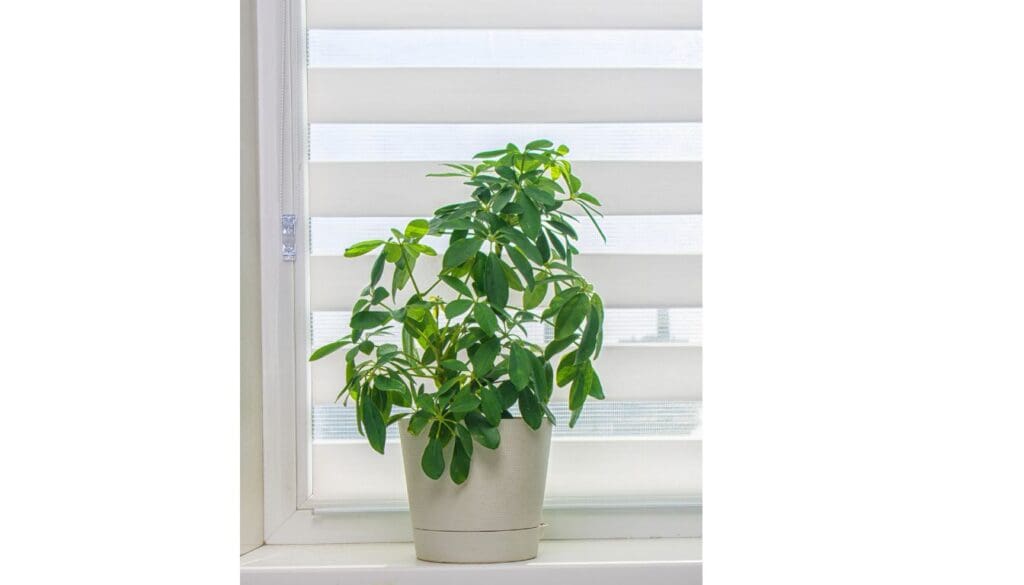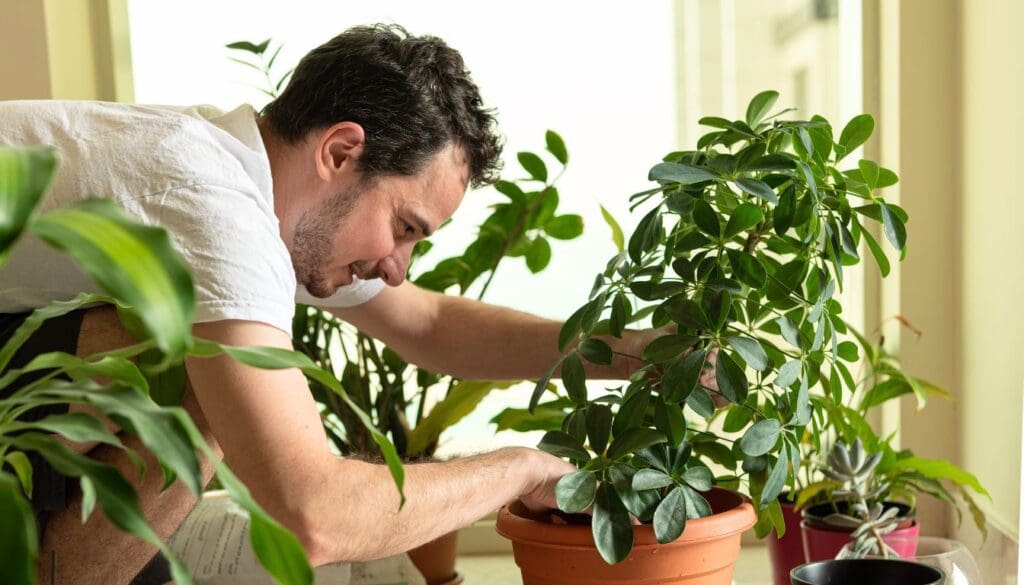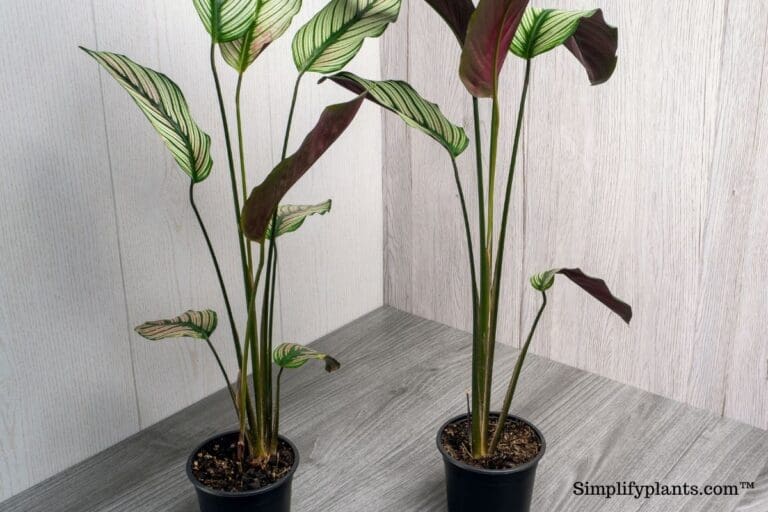Do Schefflera Plants Bloom? (When, Where & How)
Schefflera are a popular species of plants grown in homes and offices for their attractive foliage. However, plant owners often are left wondering why their plants grown indoors don’t bloom, whereas the Scheffleras in the wild do.
In general, the Schefflera plant may bloom if provided with suitable conditions. A healthy mature Schefflera blooms during summer and spring when they are most active. If you want your Schefflera to bloom, it is best to take it outdoors or keep them at a spot where it gets more daytime light.
This article will solve the confusion regarding Schefflera blooming. I will discuss the problems that do not let the plant bloom and recommend tips to encourage your umbrella plant to bloom.

Please note: Simplify Plants is reader-supported. Some links in the post are affiliate links and I get a commission from purchases made through links in the post.
Does an umbrella tree bloom?
Schefflera, or the umbrella plant, native to the tropical regions of Taiwan, China, and Australia, blooms in the wild.
However, very few bloom in cooler regions where they are grown as houseplants.
Schefflera, being warmth-loving plants, rarely flower in temperate regions.
However, in the warmer regions of Florida and Southern California, many Scheffleras have been seen blooming.
In the USDA zones, 10-11 Schefflera plants grown outdoors flowers the best.
However, those grown indoors with sufficient light, humidity, and warmth also produce flowers sometimes.
These plants produce flowers primarily in the summer season.
The Schefflera blooms depending on the species, can be red, pink, or white and accordingly vary in shape and size.
In Schefflera Actinophylla, the flowers are long and showy, with tiny flowers emerging along the length.
These flowers look like tentacles of an upside-down octopus and are clustered around the branches.
In Schefflera Arboricola, the blooms grow in more compact clusters and look like small white spikes.
How do I get my Schefflera to bloom?
Those who want their Schefflera plants to bloom should grow them outdoors for the best chances of flowering.
However, if you cannot move it outdoors, fret not.
You can also make it bloom indoors, although providing the perfect conditions is challenging.
Let us now discuss the favorable factors that will encourage your plant to flower.
These include ensuring that your plant gets ample light, water, and nutrients to produce blooms.
1. Sufficient light

The Schefflera plant prefers a lot of bright indirect sunlight to thrive and bloom.
If your Schefflera is grown indoors and you want it to flower, you need to move this plant to a spot where it receives bright light but not direct sunlight.
A covered patio or a spot near a bigger plant works well for this plant as it gives them all daylight and at the same time shields it from direct sun rays.
Be careful not to keep them directly under full scorching sunlight as that will burn and scorch the foliage.
Also read: What Kind Of Light Does A Schefflera Need?
2. High humidity
Being tropical plants, Scheffleras are a sucker for humidity.
In nature, they are grown in humid areas around the tropical regions.
Thus they cannot tolerate dry air.
This plant requires around 60% humidity to bloom, which might not be available in our homes.
However, there are ways to give that required humidity to the plant with artificial ways:
- Misting the plant is a quick and simple way to increase humidity around the plant. But since the water gets evaporated quickly, it does not give long-lasting results. However, it is also an effective way to keep the leaves clean and dust-free, which helps the plant photosynthesize well.
- Pebble trays are another effective way to increase humidity. Fill a large plate with pebbles and water and place the pot on top. As the water evaporates, the humidity will increase however you must be careful that the pot should not be touching the water.
- Humidifiers are the most effective way to increase humidity in an area. They give long-term effects, and you can increase and decrease the humidity as required.
- Grouping the plants raises the humidity and gives them an environment similar to their native lands.
- Relocate your plant to a high humidity region like the kitchen or bathroom if they have sufficient air and light.
Also read: Should I Mist My Schefflera? (+Humidity Requirement Guide)
3. Proper watering

Correct watering is an essential element for Schefflera to grow properly.
Both over watering and under watering are harmful to this plant.
Depending on the sun’s climate and intensity, you have to change the watering schedule.
Always check the soil before watering if you are unsure whether the plant needs water.
For this, dip your finger in the soil to check the moisture.
You can also use a moisture meter to be more certain about the moisture content.
In winters, it is important to let the soil dry out in between watering to reduce the chances of overwatering and root rot.
It is because the evaporation rates are much lower, and the soil stays wet for longer.
If your plant is outdoors, you can mist it in summer to keep the leaves clean and moist.
Indoors you can use a humidifier or pebble trays for the purpose.
Also read: How Much Water Does A Schefflera Plant Need? (Watering Guide)
4. Fertilization
When it comes to fertilizing, Scheffleras are medium feeders.
If you feed them too frequently, these plants may get roots burnt, and if you feed them too less, they will get weak and unable to produce flowers.
You must fertilize this plant only during the growing season and not during fall and winter when the plant is inactive.
To feed it, you can use compost or NPK 20-20-20 twice a year during March and September and if you want to make it bloom, feed it with a light liquid fertilizer every month during the spring and summers.
Water the plant a day before fertilizing as feeding in dry soil can burn the roots.
Also read: How Often Should I Fertilize My Schefflera? (+Ideal NPK Ratio)
5. Ideal temperature

These tropical plants thrive in warm, humid climates, so their ideal temperature is between 65°F to 85°F.
These plants flower only in the summer season when the temperature is ideal.
In winters, they are least active, and they cannot tolerate extremely scorching summer heat either.
It is advisable to protect these plants from heaters, air conditioners, fireplaces, etc., which tend to dry them out by sucking out their moisture.
Also read: Schefflera Plant Temperature Tolerance: Ideal Temperature+Problems
6. Soil conditions
Schefflera needs loamy, loose, well-draining, slightly moist soil like most houseplants.
They prefer slightly acidic soil with a pH around 6.0-6.5.
Adding organic elements like pine bark, compost, and sand helps to make the soil well-draining and airy.
Adding peat moss helps the soil to retain some moisture.
Do not use tight clayey soil for this plant as it tends to get compact, which is unsuitable for Schefflera.
They like to breathe and have airflow in the soil.
Clayey soil tends to get waterlogged, which is dangerous for this plant because it does not like wet soil.
Also read: What Kind Of Soil Does A Schefflera Plant Need? (+Ideal DIY Soil Mix)
7. Pruning

Prune your Schefflera occasionally during the growing season if you wish to make it flower.
Not pruning those make them grow leggy and uneven.
Pruning encourages more growth and promotes flowering by stimulating its growth hormones.
Also read: How To Prune A Schefflera Plant? (A Step-by-Step Guide)
8. Repotting
Repot the Schefflera every few years if you notice the plant has started to get too big for the pot.
The root-bound plant does not get space to expand its roots which hinders the healthy growth and flowering of the plant.
It is advisable to repot during the springtime and early summers when the plant is most active.
However, ensure the new pot is not too big for the plant as that might lead to overwatering issues.
Do not choose a pot that is more than 2 inches bigger than the existing pot.
Also, ensure the pot has drainage holes at the bottom for the excess water to escape.
Also read: How To Repot A Schefflera Plant? (A Step-by-Step Guide)
Should I cut the flowers off my Schefflera?
Many plant growers wonder whether these flowers harm the plant’s health.
Flowers increase the visual beauty of the plant, which is a sign that your plant is in the perfect condition to flourish.
However, some say that flowering takes up a lot of the plant’s energy and nutrients, which affects the plant’s overall growth.
Due to this, some people like to prune off the flowers to help the plant retain its energy and use it to push out more healthy foliage.
Why is my Schefflera not blooming?
If your Schefflera doesn’t bloom, there might be some factors acting as a barrier to the plant’s effective growth.
To encourage your umbrella plant to bloom, identify and resolve those areas so the plant can push out flowers.
Let us discuss the few common problems that hinder the Schefflera plant from blooming.
Inappropriate lighting

Insufficient lighting is the most common problem that acts as a hindrance to your indoor plants to flower.
In the case of indoor plants, we mostly do the mistake of keeping them in low lights expecting them to thrive.
Even if the plant survives in low light, it will never bloom.
To make a plant bloom, you need to give it a lot of light.
The foliage might not be affected, but it cannot produce flowers until it gets that much light.
Schefflera plants will bloom if they get ample bright, indirect light.
However, it is important not to confuse bright light with direct sunlight.
This plant cannot tolerate direct sunlight; if left under scorching sunlight, the leaves will get burnt.
Direct sunlight in the summer months will dehydrate the plants, and increasing the evaporation and transpiration process sucking out the moisture quickly, would make the foliage dry, crispy, and yellow or brown.
So if your Schefflera is not blooming, check the lighting conditions first.
Give it bright but indirect sunlight, so keep it a few feet away from a window or keep it on a bright, shaded patio.
Incorrect watering

After lighting, water plays the next most important factor that decides the health of your Schefflera.
Only the right balance of water, light, and nutrients can encourage the plant to bloom.
If one of them is not met, your plant will not bloom.
Schefflera plants are susceptible to overwatering and root rot, so you mustn’t overwater them.
If you underwater your plant for a prolonged period, it will not bloom as it will be dehydrated and weak.
Its growth will be slower, and it will not be able to produce flowers.
Pest attack
In case there is a pet in the plant, it will not be blooming despite giving it all the perfect conditions.
This is because the nasty bugs suck out the nutrients from the plant rendering them weak and vulnerable, which might not give the energy to produce flowers.
In case of pest attacks, you must wash the plant under running water and then spray Neem oil generously over the plant.
Neem oil is organic and does not harm the plant but is effective in removing pests.
Also read: Schefflera Pest Problems: Common Pests & Diseases+How To Fix
Insufficient nutrient

Along with light and water, the next most important factor that determines the health of your Schefflera is the nutrients it gets.
Schefflera plants are medium feeders, so they do not need frequent feeding; however, fertilizing in the growing season is important.
For the plant to bloom, you need to give it many macronutrients and micronutrients like magnesium, iron, phosphorous, calcium, and so on.
Those nutrients in the soil for potted plants start to get washed off with frequent watering.
Unlike those planted in the ground, potted plants have limited access to those nutrients.
So fertilizing the plants is extremely important if you want the plant to grow healthy and bloom.
Wrong soil mix
Regarding the soil mix, you must prepare the right kind of soil for the plant because every plant type has a different requirement.
Schefflera requires loamy, airy, and slightly acidic soil that can retain some moisture.
The soil mix has to be such that it does not hold the excess water but is capable of retaining moisture.
If you grow your Schefflera in heavy clayey soil, it will restrict the airflow in the roots leading to fungus growth and drainage problems.
The Schefflera will struggle if the soil mix is not suitable for the plant and will not bloom.
Temperature fluctuations

The ideal temperature for your Schefflera is between 65-90°F.
Anything above or below this will hamper your plant’s growth and will not encourage blooming.
These plants prefer moderate steady temperature and are not adapted to tolerate frequent and drastic fluctuation in temperature will shock and stresses them.
If you live in a region with frequent temperature changes or experience huge weather extremes, your plant will not bloom.
They cannot handle harsh colds and frost or extremely scorching summer. Also, keep this plant away from heaters, tents, coolers, etc.
Such fluctuations stress them, and they use their energy to adjust to the fluctuations, not letting it have more energy to produce flowers.
Poor humidity
Humidity requirement is yet another issue that most Scheffleras grown indoors suffer from.
These plants require at least 50-60% humidity to thrive and bloom, which is unavailable in most homes.
Low humidity leads to crispy wilted yellow left in the plants.
If your plant is not flowering despite having enough light, nutrients, and water, you must check whether it has the necessary humidity level.
To check the humidity levels, invest in a hygrometer, a device to measure humidity levels.
Young plant

Your plant will not bloom until it has gained maturity and a certain age.
If the plant is too young, it would need a few months or years to reach the stage when it can produce flowers.
You must have patience until then.
Tips to keep the Schefflera healthy
Let us discuss a few quick tips in a glance to keep your Schefflera healthy and happy.
- Keep the plant at a spot where it will get plenty of bright indirect light.
- Water the soil only when the top soil is dry. Avoid underwatering and overwatering.
- Feed the Schefflera generously during the growing season with an NPK 20-20-20 liquid fertilizer or compost.
- Prune the plant in the growing season to encourage branching
- Install a humidifier to maintain sufficient humidity around the plant.
- Make sure there is enough ventilation around the plant.
- Shield the plant from extreme hot air or harsh frost.
Final words

Getting your indoor Schefflera to bloom might be challenging, but it is not impossible. The most vital requirement for your Schefflera to flower is to provide the plant with plenty of light, so if you think your plant is not getting much, move it to a brighter location but not under direct sunlight.
The other important factors for flowering, as discussed above, are watering, humidity, fertilizing, and so on. You can watch your umbrella plant bloom if all the requirements are met, and your plant is healthy.
A blooming Schefflera plant is quite an occasion so enjoy them until they last.
Reference: Wikipedia, Sciencedirect, Britannica, American Society for Horticultural Science, Schefflera taxonomic history.
Recommended Garden Supplies
| Product Image | Our Recommended Gardening Supplies | Check Offers! |
|---|---|---|
Top Top
Top
Top
Top
Top
Top
Top
Top | rePotme Houseplant and Tropical Classic Potting Soil Mix | Check Offer On Amazon |
 Top
Top
Top
Top
Top
Top
Top
Top | Espoma Organic Indoor Plant Food | Check Offer On Amazon |
 Top
Top
Top
Top
Top
Top
Top
Top | GooingTop LED Grow Light 6000K Full Spectrum Clip Plant Growing Lamp | Check Offer On Amazon |
 Top
Top
Top
Top
Top
Top
Top
Top | Soil Moisture Meter | Check Offer On Amazon |
 Top
Top
Top
Top
Top
Top
Top
Top | Govee Hygrometer Thermometer, Bluetooth Enabled! | Check Offer On Amazon |
 Top
Top | LEVOIT Humidifiers for Large Room(Best For Plants) | Check Offer On Amazon |
 Top
Top
Top
Top
Top
Top
Top
Top | Upgraded DIY Automatic Drip Irrigation Kit, 15 Potted Houseplants Support | Check Offer On Amazon |
 Top
Top
Top
Top
Top
Top
Top
Top | Stainless Steel Heavy Duty Gardening Tool Set | Check Offer On Amazon |
 Top
Top
Top
Top
Top
Top
Top
Top | Bonide Insecticidal Soap | Check Offer On Amazon |
 Top
Top
Top
Top
Top
Top
Top
Top | Bonide 32 oz Spray Neem Oil for Organic Gardening | Check Offer On Amazon |
 Top
Top
Top
Top
Top
Top
Top
Top | Garden Safe Fungicide | Check Offer On Amazon |






